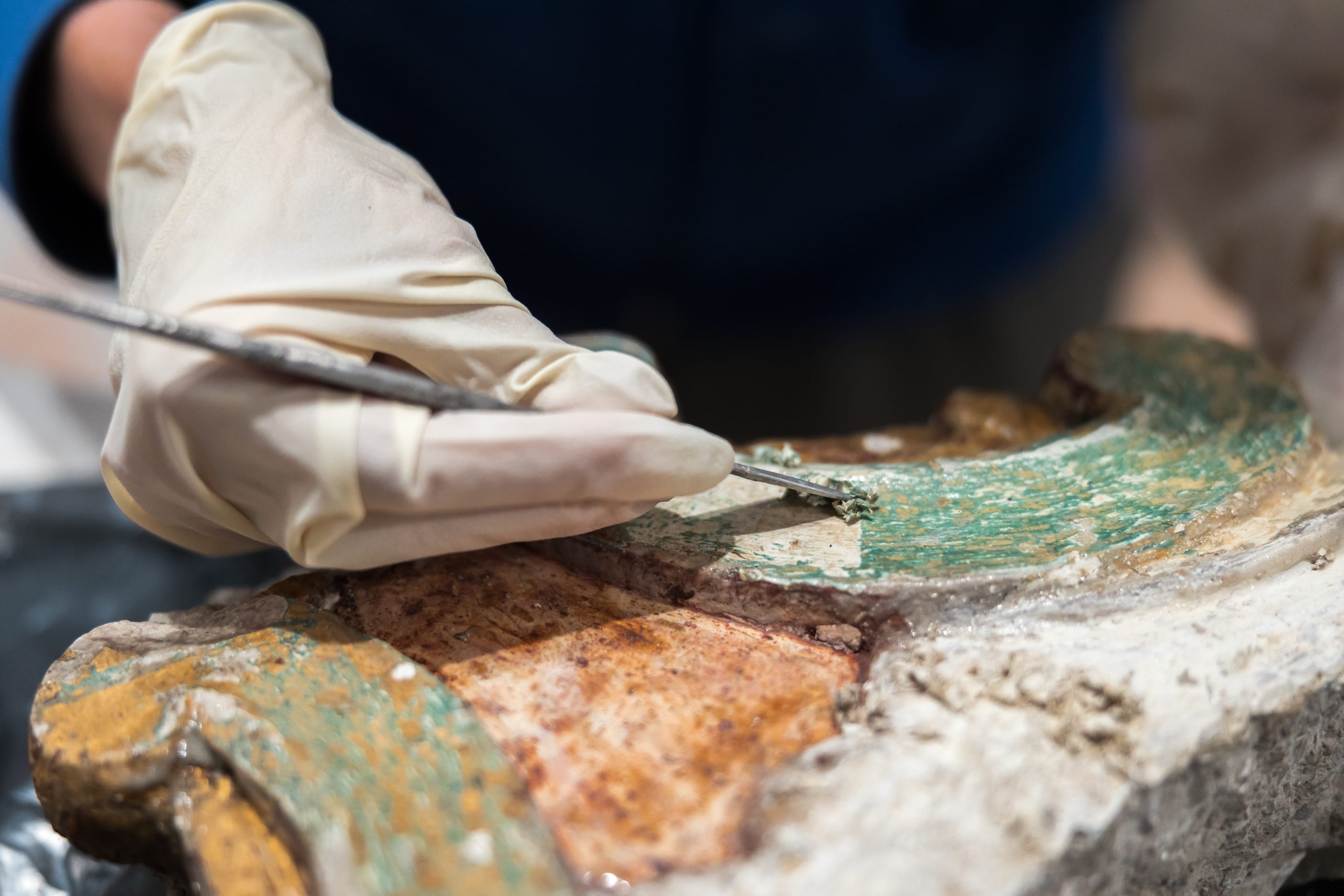Professor Piero Baglioni vividly recalls the moment that set him on a lifelong path of art conservation. It was 1966, and the young Italian chemistry student witnessed firsthand an event that would change the course of his career.
On 4 November, his home city, Florence, experienced a devastating flood, possibly the worst in the Renaissance city’s history. The disaster claimed dozens of lives and damaged millions of priceless artwork and rare books. Some masterpieces were lost forever, and others were in dire need of restoration.
“The flood impacted most of the city,” said Baglioni. “Fresco paintings in our churches were damaged, books and other artwork stored in basements were ruined.”
Preserving cultural identity
In the aftermath, experts around the world scrambled to find new ways to preserve these damaged masterpieces. One of the leading figures in this effort was Baglioni’s professor, Enzo Ferroni, who invited him to observe the city’s restoration workshops.
“I started to see art from a different angle,” said Baglioni.
That experience marked the beginning of a distinguished career. Today, Baglioni is a professor at the University of Florence and an internationally recognised expert in the conservation and restoration of cultural heritage.
He has led several major international art conservation initiatives, including a three-year EU-funded research collaboration called GREENART which will conclude in September 2025.
Building on years of studying cultural heritage conservation, the GREENART research team is developing a range of new eco-friendly solutions for the conservation and restoration of cultural artefacts, including valuable paintings, sculptures and textiles.
“
Visual art reminds us of who we are. Without it, we lose part of our identity.
The researchers’ aim is to move beyond traditional conservation techniques, many of which rely on energy-intensive processes or environmentally harmful materials. Instead, the GREENART team focuses on sustainable, non-toxic alternatives that protect both cultural heritage and the planet.
Coordinated by the Centre for Colloid and Surface Science (CSGI) at the University of Florence’s Department of Chemistry, GREENART brings together leading research institutes, chemical companies and cultural heritage organisations from across Europe and beyond. They also include partners in Brazil, China, Japan, the UK and the US.
While CSGI’s work spans a broad range of advanced technologies, GREENART is firmly rooted in the world of art.
“Why focus on art?” Baglioni asked. “Because it is part of our patrimony. Art is like a fingerprint in our mind. Visual art reminds us of who we are. Without it, we lose part of our identity.”
Baglioni also highlights the economic importance of the art sector, which provides jobs for millions across Europe and generates billions of euros in annual revenue.
“Protecting art isn’t just about preserving cultural value, it’s also about sustaining the economic ecosystem that surrounds it,” he said.
Green, greener, greenest
The innovative methods developed by the GREENART team have already earned recognition as a new benchmark in art conservation, according to Baglioni.
Paintings, which previously could only be cleaned with toxic solvents, can now be restored using complex fluids and bio-based gels. This makes the process much more efficient and environmentally friendly.
These cutting-edge techniques have already been adopted by some of the world’s most famous museums, including the Metropolitan Museum of Art in New York, the Peggy Guggenheim Collection in Venice and the Tate in London.
Museums are active partners in the development process, rigorously testing each new solution until it meets the highest standards. A high level of precision is essential, Baglioni said, especially when restoring masterpieces by the likes of Picasso, Cézanne, Pollock, Rothko and Lichtenstein.
Not resting on their laurels, the GREENART team is continuing to push the boundaries of sustainable conservation.
“We have created new systems that are fully sustainable, renewable and non-toxic,” said Baglioni. “We only use eco-friendly materials from renewable natural sources or recycled waste. It is the greenest approach possible.”
The research has resulted in a suite of new tools: cleaning gels and fluids, protective coatings, environmental sensors to monitor artworks’ conditions and sustainable packaging to safeguard objects in transit.
“When you think of art conservation, you might just think of cleaning paintings, but GREENART is so much more than that,” said Baglioni.
From canvas to skin
While the GREENART researchers’ core mission lies in safeguarding cultural heritage, their scientific innovations have applications that extend well beyond the art world.
“We have gained a lot of knowledge in material science through our work on art,” says Baglioni. “That expertise could benefit many other fields.”
One area the team has been exploring is cosmetics, in collaboration with the Japanese cosmetics company Shiseido.
“The GREENART technology is very useful for our industry,” said Dr Taku Ogura, a senior researcher at Shiseido and visiting associate professor at the Tokyo University of Science in Japan.
“Take microemulsion technology – it’s used to clean delicate artwork, but it also works brilliantly for cleansing human skin.”
“
We have created new systems that are fully sustainable, renewable and non-toxic.
As Ogura explained, these new techniques can help make cosmetic preparations cleaner and greener. Shiseido has already incorporated the technique into some of its existing products, such as a sustainable cleansing foam for makeup removal.
“This product is not only effective and easy to use, it is also more sustainable, which is very important for us,” said Ogura, who has worked on the foam himself and is proud to see it on the market.
And the potential does not stop there. Ogura believes GREENART’s technology could soon make an impact in other areas, including detergents, agriculture, and even medicine.
World Expo
To highlight this cross-sector potential – from preserving ancient canvases to advancing skincare – the GREENART project was featured at the EU Pavilion during the 2025 World Expo in Osaka, Japan.
“Participating in the World Expo is very important to us,” said Baglioni. “We want to show that technologies developed for art can have much broader applications.”
Visitors to the exhibition were introduced to GREENART’s innovative solutions for the conservation of cultural heritage and their surprising connection to the world of cosmetics.
Many even had the opportunity to try the eco-friendly products, some of which are expected to reach the market soon after the project concludes in 2025.
The World Expo was also a wonderful opportunity to expand the collaboration with Japanese partners, said Baglioni.
“To do something new, we need the right people with the right knowledge. We need the best in the world. To push the boundaries, we need international cooperation.”
Research in this article was funded by the EU’s Horizon Programme. The views of the interviewees don’t necessarily reflect those of the European Commission. If you liked this article, please consider sharing it on social media.
Showcasing EU research at the World Expo
Osaka, Japan
13 April – 13 October
This summer, millions of people from around the world will head to Osaka, Japan, for Expo 2025. At this global gathering, countries and regions will share how they’re tackling some of today’s biggest challenges, from sustainability and digital connectivity to inclusivity and security.
The central theme of this year’s event is Designing Future Society for Our Lives. Visitors will get a chance to see how EU-funded research is helping shape that future. The EU’s Nurturing Tomorrow pavilion reflects Europe’s commitment to building a greener, more connected and inclusive world.
The EU pavilion is hosting exhibitions, talks and interactive experiences that spotlight cutting-edge EU research and innovation projects – all aimed at solving real-world problems and building international cooperation. Whether you’re curious about the future of clean energy, digital tech, or inclusive design, there’s something for everyone.
Virtual visit
Can’t go to Osaka? Explore the Expo online at: https://www.expo2025.or.jp/en/future-index/virtual/virtual-site/


